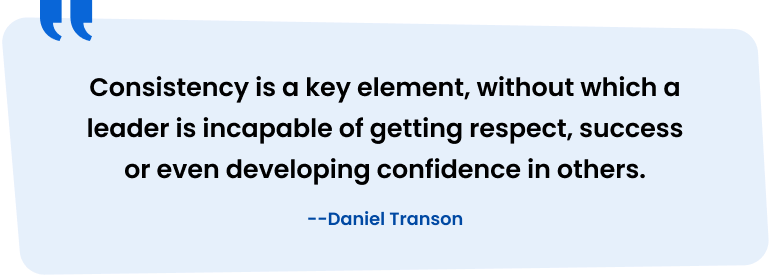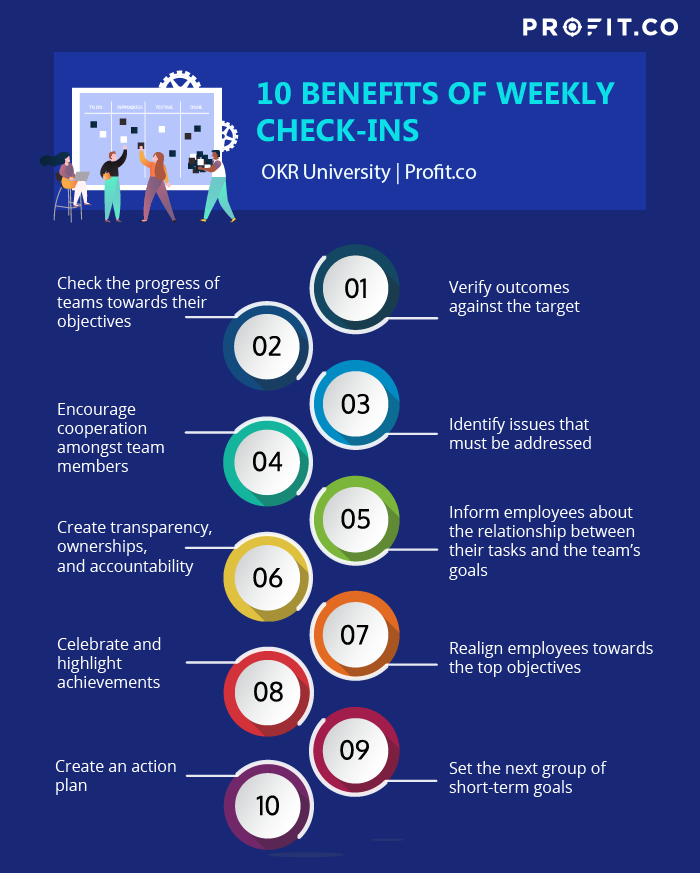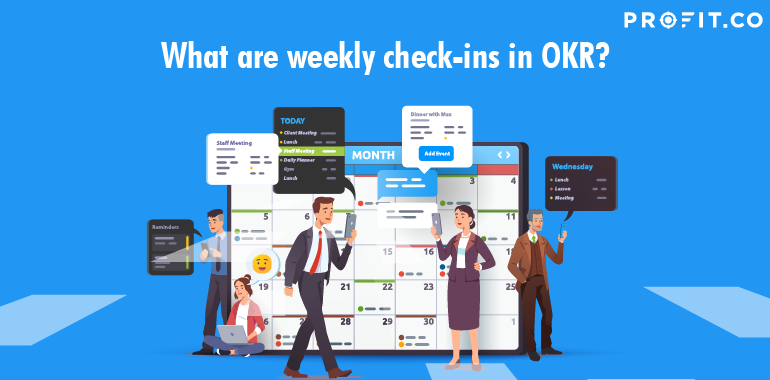

OKR weekly check-ins help in:
- Verifying outcomes against the goals
- Checking the progress of the teams towards their objectives
- Identifying issues and addressing them
- Encouraging collaboration and coordination amongst team members
- Understanding the relationship between daily activities and achievement of goals
- Creating transparency, ownership and accountability
- Realigning employees towards objectives if needed
- Celebrating achievements
- Setting the next set of short term goals
- Creating an action plan

How to prepare for a weekly check-in?
Before completing a weekly check-in, an employee must do the preparation work so as to not miss anything, and to clearly convey his/her achievements, challenges, and failures to the leaders. Following are some of the things to keep in mind while preparing for a weekly check-in.
- Spend some time reviewing your own team objectives.
- Revisit the priorities from the previous check-in.
- Reflect on the progress you have made against your goals.
- Collect all the data to substantiate your progress and the achievements you made.
- Identify the problems you encountered, things that slowed you down and the challenges you faced.
- Mention the ways with which you can overcome those challenges and solve the problems.
- Note down anything that requires clarity with regard to the objectives.
- Write down your suggestions, ideas and workarounds for problems that need to be solved.
- Look to the future and plan what you would propose to achieve towards the organization’s objectives, from your current position.
The Profit.co software allows you to complete check-ins with ease and full transparency
Steps involved in weekly check-in
1. Planning
Meetings are a part of the corporate work culture, and sometimes having so many meetings can be overwhelming. Though important, the employees can feel that a weekly check-in is just one more meeting. In order to avoid this, OKR weekly check-ins can be planned along with another meeting. For instance, the problem solving framework, scrum, can be a good match for this purpose, and you can integrate these two meetings for the convenience of the employees. It is important to standardize the cadence of the weekly check-ins and the structure of the weekly meeting in order to make life easier for the organization. Standardizing them also helps to integrate the OKR framework better in the organization. Check-ins do not necessarily have to occur on a weekly basis. They can be scheduled once every 10 days or every fortnight depending on the needs of the organization, and the duration and difficulty of the objectives. When the goals are set for a longer duration, say for a month, then there can also be an end of period check-in. It is a standard practice to do a quarterly check-in as well.It is essential for the leaders to plan a checklist for the weekly check-in meeting. The meeting needs to address the following:
- Current status of the goals compared to the previous review
- Activities and initiatives the team indulged in to move towards the objectives
- Achievements made in the last review period
- Challenges, risks and hurdles faced by the team
- The action plan for next week to move further towards the goals
Based on these expected outcomes of the meeting, the leaders can design a template for the meeting with which they can collect inputs from the team members during the meeting.
2. Evaluation
In an OKR weekly check-in, there can be a brief overview of the Key Results, comparing where the team currently is against where they were last week with regard to their objectives. Usually, key results are evaluated with templates that have a rating system in which the progress against the goals is captured with a standardized scale. The ratings correspond to the progress made towards the goals. For instance, on a scale of 0-5, a rating of 3 means 60% completion of the goals. This helps the leaders to document the outcomes, compare and track the progress in a quantitative manner and predict what the team can achieve in the future based on the current rate of progress. The achievements during the period can be celebrated briefly while keeping in mind that there is still a long way to go before the completion of organizational goals.3. Projection
Based on the metrics from successive meetings, the leaders can not only track, but also forecast progress. This helps the organization verify if the employees are on track, producing meaningful outcomes, and delivering towards the overall objectives. If the progress is not fast enough, the leaders can look into the problem and find means for the team to set goals better and deliver the outcomes faster. Based on the identified progress, they can also predict where the teams would be in the future with regard to the goals and when they would complete various milestones. These projections help to decide the future course of action for the teams and make adjustments and optimizations in the operations. One way to ensure alignment and achieve more accurate projection is measuring the confidence levels for every OKR. Using this measurement, the leaders can measure how confident the employees are in achieving the particular objective within the estimated time. Based on the current status and the challenges they have come across and overcome, employees can rate the confidence levels. A dip in confidence requires the leaders to sort out the issues and set the priorities right for the teams.4. Adjusting and setting the agenda
Weekly check-ins often result in new findings. The progress of teams towards their goals is never linear. They may face different challenges at various stages. They may come across stumbling blocks that might prevent them from progressing further. Based on these findings, the team may have to change their expectations and rearrange their priorities at least till they overcome the difficulties. Based on these changes, the action plan for the next week could change.5. Analyzing other outcomes
Objectives and Key Results not only quantifies progress against objectives by evaluating outcomes but also assesses outcomes that do not necessarily fall within the preview of OKR. For example, in OKR, the team outcomes outweigh an individual’s achievements. So, teamwork, coordination in producing team outcomes, and cross-functional synergies can be analyzed in a weekly check-in by comparing what individuals say with the details obtained from other means, such as performance reviews. Any significant inconsistency or disparity between those two sources of information would mean there is some problem with teamwork, and the leaders can implement team building measures.6. Addressing the challenges
Challenges, failures, and roadblocks can arise at any stage of the journey towards the goals. So, identifying the challenges and assessing the reasons for failure are important components of OKR weekly check-ins. It is crucial for teams to sit with the leaders and work out a solution to overcome those problems, find solutions and workarounds, and convert failures into success quickly.Do’s and Don’ts of Weekly Check-In
- Involve the leaders in the planning and ensure participation of all key stakeholders in the weekly check-in.
- Collect up-to-date data while preparing for the weekly check-in.
- Set a cadence, weekly timing, and a fixed structure for the weekly check-in and stick to them.
- Convince the employees about the importance of the weekly check-ins and work to integrate them as a part of the organization culture.
- Allow participation of the employees in contributing towards the achievement of OKRs.
- Do not allow presentations about tasks completed. OKR should be all about team outcomes towards the objectives.
- Involve a moderator to regulate the discussions and bring actionable outcomes from the weekly check-in.
- Do not keep OKR rigid. Adjust the objectives in the first few meetings and optimize them.
- Brainstorm with the teams regarding the learnings, challenges, and workarounds.
- Keep documenting the progress, ideas, solutions, and suggestions that come out of the weekly check-ins.
- Do not proceed with OKRs and action plans without consensus from the team members. Check the OKRs and revise them if needed. Ensure that the team has synergy and cohesiveness when there is a lack of consensus.
- Celebrate all the small achievements that improve confidence levels. But do not analyze and judge how employees made that achievement.
- Do not force new goals on the teams. Empower them to choose their own, more challenging goals.
- Facilitate the discussion to help the teams identify and set their goals.
- Capture the confidence levels, document all the findings, key points, and goals agreed upon, and send them across to the team members.



